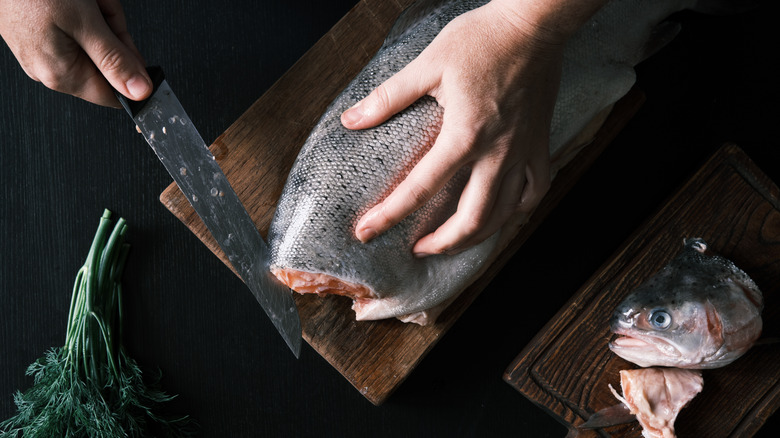The Only Tool You Need To Descale Fish Is A Spoon
Fish is generally a fast-cooking food with an array of nutritional benefits. If you buy it whole, however, or catch a mess of it yourself, there's some work to be done before you can fillet and cook it. "Cleaning" a fish involves disposing of the gills, blood, and guts, along with the animal's skin and scales. Descaling is not absolutely necessary, and many cuisines the world over serve fish whole, scales, head, and all. Still, unless you're grilling a whole fish, plenty of recipes call for the scales to be removed, and there's a bit of a trick to this step — you can't just pull fish skin off the way you remove the silver membrane from ribs. Thankfully, there's a fish prep tip that will keep you from needing to buy a descaling tool to accomplish the job.
If you have a spoon, you have everything you need to get the scales off the star aquatic protein of your next meal. The spoon method to descaling has other benefits beyond requiring only standard kitchen silverware. For one, it preserves the integrity of the scales so that they can be used in art, if that's of interest to you. Perhaps the biggest boon for home cooks is that it's generally less messy than conventional fish descaling methods, which are infamous for leaving scales all over your kitchen prep area. Finally, though not entirely foolproof, this life-changing kitchen hack is easy and takes just a moment to learn.
Tips for descaling fish with a spoon
The key to this technique is using the edge of the spoon's round portion to scrape the scales off the fish's body; how you hold the spoon is up to you. One method is to turn it upside-down so that the convex "bowl" faces the ceiling. This position, combined with carefully working the spoon under the scales, leads to less mess and does a better job at not destroying them in case you want to use them later. You can also hold the spoon vertically, with its thin side edge facing the ceiling, and use a more scraping vigorous motion. This can be quicker but messier. Descaling like this in an open garbage bag placed on your counter mitigates the need for excessive cleanup afterwards.
When scraping, move from the tail down to the head, always working against the grain of the scales. You'll know you're moving against the grain if you feel resistance. Use enough pressure to strip off the scales without damaging the flesh. (And don't forget the fish's belly, where there are small scales that also need to be removed!)
To check that you've done a thorough job, you can run your hands along the skin to make sure all the scales are gone — stragglers will be easy to feel with your fingers and can be rinsed off. Once everything feels slick and smooth, the descaling step is done, and you're ready to progress with your fish prep.

